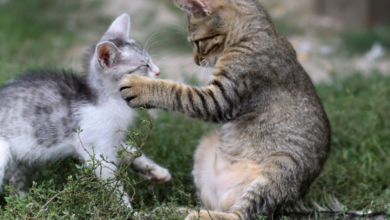5 Dangers Of Letting Your Cat Outdoors

Picture this: your cat, with eyes full of curiosity and whiskers twitching with excitement, steps out into the great unknown of the outdoors. While it’s a thrilling adventure for your furry friend, the outside world is rife with dangers lurking in every corner. As responsible pet parents, it’s crucial to understand these threats and take proactive measures to ensure the safety and well-being of our beloved feline companions.
1. Predators:
In the moonlit realm of the great outdoors, danger prowls in the form of stealthy predators, casting a shadow over the adventures of our feline companions. As the guardians of our beloved cats, it’s crucial to understand the lurking threats and devise strategies to ensure their safety amidst the wilderness of the neighborhood.
What are the predators?
From the enigmatic silhouette of the coyote to the majestic swoop of a nocturnal owl, predators are an ever-present force in the nocturnal tapestry of the outdoors. These creatures, driven by instinct and hunger, see our feline friends as potential prey, turning a midnight stroll into a perilous game of survival.
How they hunt…
With silent footsteps and keen senses, predators stalk their unsuspecting quarry under the cover of darkness. For outdoor cats, this poses a significant risk, especially in areas where urban sprawl meets untamed wilderness. The allure of exploration may lead them into the domain of these formidable hunters, putting them in harm’s way.
How to nullify the predators
To safeguard our feline friends from the clutches of nocturnal predators, we must take proactive measures to fortify their outdoor sanctuary. Here are some strategies to consider:
1. Secure Enclosures:
Constructing a sturdy outdoor enclosure or “catio” provides a safe haven where cats can bask in the fresh air without the looming threat of predators.
These enclosures can be customized to suit your cat’s needs, offering ample space for play and relaxation while keeping predators at bay.
2. Supervised Outdoor Time
While the call of the wild may beckon, it’s essential to supervise your cat’s outdoor adventures, especially during dusk and dawn when predators are most active.
By keeping a watchful eye, you can intervene if any danger arises and ensure your cat returns safely to the comfort of home.
3. Motion-Activated Lights and Alarms:
Installing motion-activated lights and alarms around your property can serve as a deterrent to nocturnal predators, alerting them to the presence of humans and discouraging them from venturing too close. These devices can help create a safer outdoor environment for your cat to explore.
4. High Perches and Escape Routes:
Providing elevated perches and escape routes in your outdoor space allows your cat to survey their surroundings and quickly retreat to safety if threatened.
Trees, cat trees, and elevated platforms offer vantage points where cats can feel secure while keeping a watchful eye on potential predators.
Conclusion:
In the intricate dance between predator and prey, our feline friends rely on us to be their stalwart protectors in the vast expanse of the outdoors.
By understanding the lurking threats of nocturnal predators and implementing thoughtful solutions, we can create a haven where cats can roam freely, safe from harm’s reach. Let us stand as guardians of the night, ensuring that our beloved companions can embrace the wonders of the wilderness with confidence and security.
2. Traffic
Imagine a cat’s-eye view of the world, where towering vehicles speed by in a cacophony of noise and motion. For outdoor cats, the allure of exploration may lead them into the heart of this bustling landscape, unaware of the imminent danger that lurks around every bend. From busy intersections to quiet cul-de-sacs, traffic poses a constant threat to our feline friends, turning their outdoor escapades into a high-stakes adventure.
The Silent Sentinel:
As the silent sentinel of the streets, traffic presents a myriad of risks to outdoor cats. The roar of engines and the rush of passing vehicles can startle even the most seasoned adventurer, leading to accidents and injuries. From speeding cars to oblivious drivers, the urban landscape is fraught with peril, making it essential for pet parents to be vigilant guardians of their cat’s safety.
Solution
To protect our furry friends from the perils of traffic, we must take proactive measures to pave the way to safety. Here are some strategies to consider:
1. Establish Safe Boundaries:
Create a designated outdoor space for your cat that is away from busy roads and intersections. Fenced-in yards or enclosed patios provide a secure environment where cats can explore without the risk of encountering traffic.
2. Supervised Outdoor Time:
When allowing your cat to venture outdoors, always supervise their adventures to ensure their safety. Keep a watchful eye on your cat and intervene if they stray too close to traffic or unfamiliar areas.
3. Use Visual Deterrents:
Utilize visual deterrents such as reflective collars or brightly colored tags to make your cat more visible to drivers, especially during low-light conditions. These simple measures can help alert motorists to the presence of your cat and reduce the risk of accidents.
4. Microchip and ID Tag:
Ensure your cat is microchipped and wears a collar with an identification tag containing your contact information. In the unfortunate event that your cat becomes lost or injured, these identifiers can help reunite you with your furry friend and ensure they receive prompt medical attention.
Conclusion:
In the urban jungle where danger lurks around every corner, our feline friends rely on us to be their steadfast protectors against the perils of traffic. By understanding the risks posed by speeding cars and busy streets and implementing thoughtful solutions, we can create a safer outdoor environment where cats can roam freely, secure in the knowledge that they are shielded from harm’s reach. Let us pave the way to safety for our beloved companions, ensuring that their neighborhood adventures are filled with joy and security.
3. Poisoning:
Picture your cat, with eyes full of wonder, exploring the lush foliage of your backyard oasis. While the vibrant colors and enticing scents may beckon, not all that glitters is gold.
Many plants commonly found in gardens and parks can harbor toxic compounds that are harmful, and even lethal, if ingested by our feline friends. Additionally, household chemicals such as antifreeze, pesticides, and cleaning agents pose a grave risk if accidentally consumed.
The Deadly Dance:
In the intricate dance between predator and prey, our feline friends may inadvertently stumble upon these hidden toxins, mistaking them for harmless playthings or succulent treats.
From nibbling on toxic leaves to lapping up spilled chemicals, cats are at risk of poisoning in their outdoor escapades. The consequences can be dire, ranging from mild gastrointestinal upset to organ failure and even death.
Possible Solutions…
To protect our cats from the perils of outdoor poisoning, we must cultivate a safe haven where danger is kept at bay. Here are some strategies to consider:
1. Know Your Plants:
Educate yourself about the plants in your outdoor environment and identify any that may be toxic to cats. Common culprits include lilies, azaleas, tulips, and daffodils, among others. Consider replacing toxic plants with feline-friendly alternatives to eliminate the risk of accidental poisoning.
2. Create a Safe Zone:
Establish a designated outdoor space for your cat that is free from toxic plants and hazardous chemicals. Enclose the area with fencing or create a secure outdoor enclosure, known as a “catio,” where your cat can safely explore without the risk of encountering toxins.
3. Monitor Outdoor Access: Supervise your cat’s outdoor adventures to ensure they steer clear of potentially hazardous areas. Keep a watchful eye on your cat and intervene if you notice any signs of curiosity towards toxic plants or substances.
4. Store Chemicals Safely:
Store household chemicals, such as antifreeze, pesticides, and cleaning agents, in secure containers and keep them out of reach of your cat. Clean up spills promptly and dispose of unused chemicals properly to minimize the risk of accidental ingestion.
Conclusion:
In the verdant landscape of the outdoors, our feline friends face hidden dangers that can threaten their health and well-being. By understanding the risks of outdoor poisoning and implementing proactive measures to safeguard against them, we can create a sanctuary where cats can roam freely, secure in the knowledge that they are protected from harm’s reach. Let us cultivate a safe haven for our beloved companions, ensuring that their outdoor adventures are filled with joy and peace of mind.
4. Disease and Parasites:
Imagine your cat, with whiskers twitching and tail held high, exploring the untamed wilderness of your backyard. While the sights and scents may captivate their senses, hidden dangers lurk beneath the surface.
Outdoor environments are teeming with disease-causing pathogens such as feline leukemia virus (FeLV), feline immunodeficiency virus (FIV), and rabies, which can pose a grave risk to our feline friends.
Additionally, parasites such as fleas, ticks, and intestinal worms can hitch a ride on unsuspecting cats, causing discomfort and potential health complications.
The Stealthy Invaders:
In the intricate dance between host and parasite, our feline friends may unknowingly become hosts to these invisible invaders, setting the stage for a battle against unseen foes.
Whether through direct contact with infected animals or by encountering contaminated environments, outdoor cats are at risk of contracting diseases and parasites that can impact their health and quality of life.
How to handle “Disease and Parasites.”
To shield our cats from the invisible threats of disease and parasites, we must fortify their defenses against these silent invaders. Here are some strategies to consider:
1. Regular Veterinary Care:
Schedule regular check-ups with your veterinarian to ensure your cat is up-to-date on vaccinations and preventative medications for diseases and parasites. A comprehensive wellness exam can detect early signs of illness and allow for prompt intervention.
2. Parasite Prevention:
Implement a regular parasite prevention regimen to protect your cat from fleas, ticks, and intestinal worms. Consult with your veterinarian to determine the most appropriate preventative products based on your cat’s lifestyle and risk factors.
3. Outdoor Supervision:
Supervise your cat’s outdoor adventures to minimize their exposure to disease-causing pathogens and parasites. Keep a watchful eye on your cat and intervene if you notice any signs of illness or discomfort.
4. Environmental Management:
Take steps to minimize your cat’s exposure to disease-carrying wildlife and contaminated environments. Keep outdoor areas clean and free of debris that may harbor parasites, and discourage contact with unfamiliar animals that may carry infectious diseases.
Conclusion:
In the vast expanse of the outdoors, our feline friends face invisible threats that can jeopardize their health and well-being. By understanding the risks of disease and parasites and implementing proactive measures to fortify their defenses, we can create a sanctuary where cats can explore the wonders of the natural world with confidence and security. Let us stand as vigilant guardians, ensuring that our beloved companions are shielded from harm’s reach as they embark on their outdoor adventures.
5. Injuries:
Picture your cat, with eyes full of wonder and whiskers twitching with excitement, embarking on a grand outdoor adventure. While the world beyond the doorstep holds boundless possibilities, it also harbors hidden dangers that can lead to unforeseen injuries. From encounters with other animals to mishaps during exploration, outdoor cats face a myriad of risks that can result in cuts, scrapes, and more serious wounds.
The Perilous Path:
In the intricate dance of outdoor exploration, our feline friends may encounter obstacles and adversaries that put them in harm’s way. Territorial disputes with other animals, such as rival cats or territorial dogs, can escalate into physical altercations, leading to injuries such as bites and scratches. Additionally, accidents such as falls from trees or entanglement in fences can result in trauma that requires immediate attention.
Solution: Paw-sitive Prevention
To protect our cats from the perils of outdoor injuries, we must take proactive measures to mitigate the risks and ensure their safety. Here are some strategies to consider:
1. Provide Safe Boundaries:
Establish a designated outdoor space for your cat that is secure and free from potential hazards. Enclosed gardens, catios, or fenced-in yards provide a safe environment where cats can explore and play without the risk of encountering dangerous obstacles or adversaries.
2. Supervise Outdoor Time:
Whenever your cat ventures outdoors, keep a watchful eye on their adventures to intervene if any potential dangers arise. Monitor their interactions with other animals and provide guidance to prevent confrontations that could lead to injuries.
3. Create Escape Routes:
Ensure that your outdoor space includes multiple escape routes and elevated perches where your cat can seek refuge if they feel threatened or encounter danger. Trees, shelves, and cat trees provide vantage points where cats can survey their surroundings and retreat to safety if necessary.
4. Prompt Medical Attention:
In the event that your cat sustains an injury, seek prompt medical attention from your veterinarian to assess the severity and provide appropriate treatment. Prompt intervention can prevent minor injuries from escalating into more serious health complications.
In summary:
In the wild expanse of the great outdoors, our feline friends rely on us to be their steadfast protectors against the risks of injury and harm. By understanding the potential dangers and implementing proactive measures to safeguard against them, we can create a safe and enriching outdoor environment where cats can explore with confidence and joy. Let us embark on this journey together, ensuring that our beloved companions can roam the world with resilience and grace, knowing that they are protected every step of the way.
Conclusion:
As guardians of our feline friends, it’s our responsibility to be vigilant stewards of their safety in the outdoor realm. By understanding and mitigating the risks posed by predators, traffic, poisoning, diseases, and injuries, we can provide our cats with a safe and enriching outdoor experience. Let’s embark on this journey together, armed with knowledge and compassion, to ensure that our beloved companions can explore the wonders of the world with joy and security.



